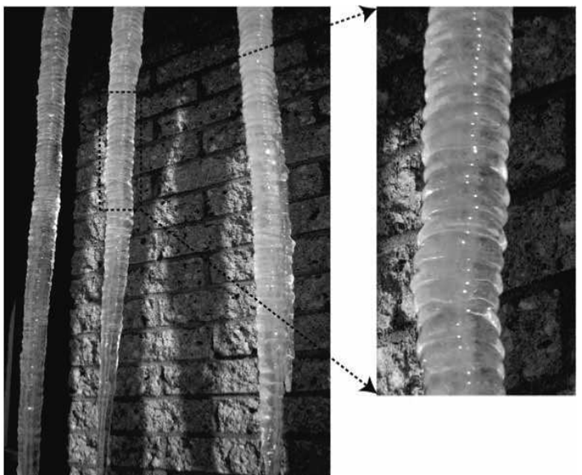The Curious Properties Of Ripples On Icicles
A strange feature of icicles is that their surfaces can sometimes become rippled, as in the picture above. The wavelength of these ripples is always about a 1cm.

About ten years ago, Kazuto Ueno, now at the Université du Québec á Chicoutimi in Canada, developed a theoretical model to explain this phenomenon.
His thinking goes like this. Icicles are covered in a thin layer of water supercooled to less than 0 degrees C and this flows under the force of gravity. When this layer freezes, it releases heat which can radiate away more easily from the convex part of a ripple than the concave part. So ice preferentially forms over the convex areas, making them bigger.
The surface of icicles start off smooth but any small perturbation in the flow of water over them creates ripples which quickly freeze in this manor. The wavelength of these ripples is determined by the heat transport properties of water flowing over ice, which are roughly constant and so explains the constant wavelength. Voila!
However, Ueno’s model makes three other predictions about these ripples which have never been observed until now. First, that the wavelength of ripples should increase as the angle of the inclined plane decreases; second that the wavelength should increases only gradually with an increase in the water supply; and finally that the ripples should move upward at about half the speed of the mean growth rate.
Today, he and a few pals reveal the results of their efforts to test these predictions both in numerical simulations and in laboratory experiments.
The bottom line is that they confirm the predictions. The wavelength can change in the way he predicted and ripples move slowly upwards, even though the water is flowing down.
There’s an interesting corollary to all this. In this work, the water always flows under the force of gravity. But what happens when aerodynamic forces also come into play or, in other words, how does wind effect the ripples?
That’s important because it could shed light on the process of freezing on aircraft wings and turbines, a significant and potentially life threatening problem.
Ueno and co say they’re looking into this very question and will let us know when they find out.
Ref: arxiv.org/abs/1102.4890: Numerical And Experimental Verification Of A Theoretical Model Of Ripple Formation In Ice Growth Under Supercooled Water Film Flow
21 March 2011 Correction:
Kazuto Ueno writes that the following sentence in this post does not represent his view: “When this layer freezes, it releases heat which can radiate away more easily from the convex part of a ripple than the concave part. So ice preferentially forms over the convex areas, making them bigger.”
Instead, he provides the following explanation: “any convex part of the water-air interface is slightly shifted upwards against that of the ice-water interface, then the release of the latent heat is large on the upstream side of any convex part of the ice-water interface. This means that ice grows faster on the upstream side than on the downstream side of any convex part of the ice-water interface. As a result, not only does the amplitude of the ripples grows, but the ripples also move upward with time as experimentally observed.”
Keep Reading
Most Popular
Large language models can do jaw-dropping things. But nobody knows exactly why.
And that's a problem. Figuring it out is one of the biggest scientific puzzles of our time and a crucial step towards controlling more powerful future models.
The problem with plug-in hybrids? Their drivers.
Plug-in hybrids are often sold as a transition to EVs, but new data from Europe shows we’re still underestimating the emissions they produce.
How scientists traced a mysterious covid case back to six toilets
When wastewater surveillance turns into a hunt for a single infected individual, the ethics get tricky.
Google DeepMind’s new generative model makes Super Mario–like games from scratch
Genie learns how to control games by watching hours and hours of video. It could help train next-gen robots too.
Stay connected
Get the latest updates from
MIT Technology Review
Discover special offers, top stories, upcoming events, and more.